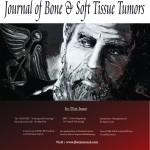Paediatric Bone Tumours
Vol 1 | Issue 2 | Sep- Dec 2015 | page:3 | Dr Subin Sugath.
Author: Dr Subin Sugath [1].
[1]Orthopaedic Oncology Clinic, Pune, India.
[2] Indian Orthopaedic Research Group, Thane, India
[3] Sancheti Institute for Orthopaedics &Rehabilitation, Pune, India
Address of Correspondence
Dr. Subin Sugath MS Orth.
Department of Ortho Oncology.
Aster DM Healthcare Pvt Ltd. Kuttisahib Road, Near Kothad
Bridge, South Chittoor PO, Cheranallor, Kochi 682 027,
Kerala, India.
Email: drsubin.sugath@dmhealthcare.com
Paediatric Bone Tumours
Bone tumours are rare as they constitute less than 2% of all malignancies. Though they can affect any age group, paediatric age group forms one of the commonest subsets affected by this. Osteosarcoma and Ewings Sarcoma, two common primary malignant bone tumours are commonly seen in patients less than 20 years of age. Since Ewings sarcoma was discussed in details in the last issue of the journal, the present symposium tries to cover certain general aspects of paediatric bone tumors in some details rather than discussing individual tumors. The outcome of treatment of this malignancy has seen a drastic improvement with the use of more potent chemotherapeutic drugs, newer imaging modalities which tell you the exact extent of these tumours and improved surgical techniques. The overall survival and disease free survival have increased from the dismal levels prevalent in the eighties to promising new levels. Amputation which was the choice of treatment earlier has been replaced by limb preserving surgeries where only the diseased bone is removed rather than the entire affected limb. An adult and a paediatric patient cannot be equated when it comes to management of bone tumours. The challenges in treating a child with bone tumour are more considering the age, size of the patient and bone, the remaining growth potential and the difficulty in using conventional reconstruction options after tumour resection. An open physis can be considered as a thick barrier to tumour spread and can be taken as a margin while doing tumour resection in children. The concept of margin and their implications in tumour surgery in children has been discussed in the article by Prof. K.C Gopalakrishnan [1]. The article is written from a surgical anatomy/pathology point of view and will be very helpful in understanding the basic of natural barriers and spread of tumors. Conventional reconstruction technique using prosthesis causes limb length discrepancy at the time of skeletal maturity as the unoperated limb grows normally while the operated limb doesn’t as the growth plate is also removed during the tumour excision. Different reconstruction options which can overcome this are discussed in detail in the article by Prof. Robert Grimer [2]. The decision making between limb sacrifice and limb salvage is difficult one both for the patient and for the surgeon. Factors like life span, limb function, patient’s wishes and expected limb function will help guiding the decision. At times, this decision may be quite difficult and may challenge even a lifetime experience of an orthopaedic oncology surgeon [2]. Expandable implants which can be lengthened over a period of time to compensate for the growth of the contralateral limb has come a long way in making prosthetic replacement an acceptable option in children with bone tumours. Various biological methods of reconstruction using autografts and allografts have their own advantages as it can be a lifelong solution once they incorporate with the host bone. Reimplantation of the tumour bone after sterilisation is also now accepted as a reconstruction option in children. Intercalary resections where the natural joints can be preserved require precise surgical resections to attain both oncological clearance and also to have a viable reconstruction option. Computer Assisted Orthopaedic Surgery (CAOS) has come a long way in helping to attain this goal. The benefits of this technique are explained in the article by Prof. Lee Jeys where he also discusses the use of CAOS in complex pelvic surgeries [3]. The benefits of using high dose methotrexate has been debated for long. Although methotrexate is been use since 1960’s, the currently literature still does not have enough evidence to recommend for or against its use. Some studies have shown strong positive effect while others have shown no advantage. The use of high dose methotrexate based chemotherapy has been outlined in the article by Dr Vivek Radhakrishnan [4]. They have also tried to review the important existing literature and provide recommendation for use of high dose methotrexate in paediatric osteosarcomas. Applicability of high dose methotrexate is also discussed in the Indian scenario and this may be applicable to most developing world countries. In all keeping up with the multidisciplinary approach discussed in the editorial [5], the current symposium has tried to present anatomical/pathological, surgical and medical aspect of bone tumors along with recent advances in the field. Children with bone tumours need to be treated differently from adults while considering the management and I hope these series of articles will help to enlighten us in the management of these complex problems.
Dr Subin Sugath
References
1. K C Gopalakrishnan. Natural “Barriers” Its Relevance To The Spread Of Bone Sarcoma. Journal of Bone and Soft Tissue Tumors Sep-Dec 2015;1(1):5-9.
2. Parry M, Grimer R. Limb Salvage in Paediatric Bone Tumours. Journal of Bone and Soft Tissue Tumors Sep-Dec 2015;1(2):10-16.
3. Archer JE, May PL, Jeys LM. CAOS in Paediatric Bone Tumour Surgery. Journal of Bone and Soft Tissue Tumors Sep-Dec 2015;1(1):17-21.
4. Reghu K S, Radhakrishnan V S. High dose Methotrexate in Paediatric Osteosarcoma – a brief overview. Journal of Bone and Soft Tissue Tumors Sep-Dec 2015;1(1):22-24.
5. Panchwagh Y, Shyam AK. M.D.T. (Multi Disciplinary Team) For Sarcomas: A Must ! Journal of Bone and Soft Tissue Tumors Sept- Dec 2015; 1(2):1-2.
| How to Cite this article: Sugath S. Paediatric Bone Tumours. Journal of Bone and Soft Tissue Tumors Sep-Dec 2015; 1(2): 3-4. |
(Abstract) (Full Text HTML) (Download PDF)




